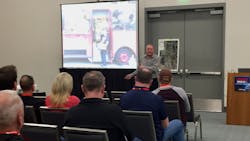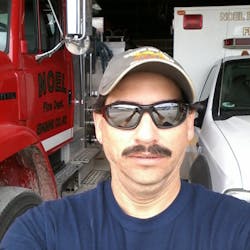FHWorld18: NorCal Fire Storm Created Numerous Challenges
“It was unimaginable.”
That was a phrase that Sonoma Valley, CA, Fire & Rescue Authority Battalion Chief Bob Norrbom used repeatedly during his session at Firehouse World as he shared his experiences from commanding the Nuns Fire during the NorCal Fire Storm that devastated the popular wine country in the Sonoma Valley region in October 2017.
Three other incidents—the Atlas, Tubbs and Pocket fires—were all reported the same night as the Nuns fire, thus quickly depleting the region’s resources. It left some firefighters on the front lines for days before relief arrived.
Ironically enough, another fire in the region was called the Norrbom Fire, located just southeast of the Nuns fire. That fire eventually merged with the Nuns fire.
“I’m glad that wasn’t my fire, I don’t think you want a fire named after you.”
The fire
The Nuns started in Glen Ellen, the town where Norrbom lives, around 10 p.m. on Oct. 11, but it wasn’t the only fire in the region. The first 9-1-1 caller around 10 p.m. reported that they were trapped by fire.
It was fueled by winds that gusted to 60 mph and the relative humidity was at less than 10 percent, so the dry, brittle brush was waiting to burn.
Realizing the severity of the fire and the danger it posed to hundreds of structures, Norrbom called for additional resources immediately. He was told he was on his own for a while and that set the course for the next few days.
“That was, right off the bat, a unique challenge for me. I had never seen that in my career,” Norrbom said. “This was unprecedented in our community and very challenging for our agency. If this were L.A., it wouldn’t have been such a problem because of their resources.”
Commanders at the nearby Tubbs fire requested 170 engines, but only 95 responded. For the Atlas Fire, only 35 of the 135 engines requested were sent.
Noorbom said three fires never received a single extra resource.
The first hours
Telephone service in the area was taken out early in the fire, so when the local agencies tried to alert residents to evacuate, the system failed and the warnings were not sent out, leaving hundreds unaware of the exploding fire in their neighborhoods..
Many residents were already in bed and were either alerted to the fire by someone knocking on their door, or being awoken by the high winds that knocked down trees or even the sounds of the roaring blaze.
“It was pretty much us and law enforcement going door-to-door trying to get people out,” Norrbom said the of the dire evacuation process. “There was a lot of neighbors helping neighbors…all good stories.”
Unlike most wildfires where crews focus on establishing perimeters to stop the fire from spreading, his limited resources were assigned to structure protection.
“We had to write some of our own pages on this incident.”
Only three hours into the fire, he realized he needed his off-duty personnel to return. He used the department’s paging application to send a recall notification to all of the members. It simply read: ““Large fire. Return to work. Mandatory.”
“It was awesome, we had 75 personnel back within 24 hours,” but he said that created unexpected challenges.
While firefighters had their PPE, all of the department’s resources were committed to firefighting operations so they staffed spare apparatus and pickup trucks.
“We had sold a truck to another department and they didn’t pick it up yet. The guys loaded it with hose and equipment and they went out and that saved houses.”
The department has discussed holding on to pickup trucks for longer periods to have extra vehicles on hand for incidents in the future.
Unexpected resources
Area residents were often found trying to battle fires on their own and Norboom shared a few stories about civilians who jumped in to help. He showed a photo of two bulldozers cutting a fire line as a wall of flames approached them.
“Both of these bulldozers you see here, they were not assigned, but they showed up to help,” Norrbom said with a laugh.
He said one of the drivers told his former employer that he needed the rig to help build fire lines and the other driver used his job’s equipment to cut fire lines.
“It did a lot of good and we call him a local hero.”
Others provided water tankers to shuttle water to the scene. Sometimes, it was the only water source for crews engaged in structure protection.
“Right or wrong, we made a risky decision to use them and it worked…if we sent them home, then we would’ve been the bad guys,” he said. “If you’re not putting the fire out in your community, and we were doing the best we could, other people will do it. You gotta be prepared to deal with that.”
9-1-1 calls
Dispatchers and 9-1-1 call takers were overwhelmed with the number of calls and radio traffic. Norrbom played audio that showed the level of stress on both sides of the phone. Frantic callers looking for answers and dispatchers trying to come up with solutions.
“I feel bad for not only the citizens, but the dispatchers who were trying to handle this,” he said.
Frantic callers were saying they were cut off by fire, or surrounded in their homes by fire and were asking what to do.
“A lot of people went in their pools. It probably saved a lot of lives, but that might not have been the best thing to do,” Norrbom said. “We need to have those plans in place before, not at the beginning.”
Similar to what is done to help callers with medical emergencies, the county is now looking at re-vamping their processes, including pre-written scripts that will help dispatchers communicate evacuation plans to callers.
By the numbers
Four of the top 20 most destructives in 100 years broke out on Oct. 11, 2017, and it's been named the Northern California Firestorm.
Between Oct. 8-15, 250 fires were reported across California, with 21 of them being classified as large fires.
In the end, 11,000 firefighters from 17 states and two countries responded to the blazes that consumed 250,000 acres, 26,000 structures and left 46 people dead.
The Nuns Fire consumed over 54,000 acres and destroyed 1,300 structures.
Contract firefighter Garrett Paiz died while operating a water tender and one resident—who didn’t evacuate—died in the fire.
Most of the outside resources showed up at the Nuns Fire days later, only after they were released from the other fires in the region.
Lessons learned
“Every day there are new things coming out on these incidents.”
The department has had community meetings and internal meetings to determine what lessons to pull from the tragedy.
Here are some of the lessons Norrbom shared from the Nuns Fire:
- Prepare for logistics issues, including food and water, portable restrooms and fuel needs. The fire stations were the only place to get fuel in the area and they needed a constant stream of fuel resupplies.
- Crews need to establish safety rules and communicate changes and conditions as often as needed.
- Unassigned crews who arrive at a base camp check in with command immediately so that they can be deployed, if needed. Commanders were sometimes unaware that firefighters were ready to go to the fire lines.
- By using the department’s paging application, he didn’t have to assign firefighters to staff phones and call back members.
- Make sure all members have photo IDs. Many of the off-duty firefighters who returned did not have them, so police would not allow them past the blockades. Many of them had to drive long distances to get to the stations.
- Limited resources prevented commanders from assigning crews to tactical patrols and he said that decision caused problems in some areas where spot fires and embers caused fires to flare up. He added that it was the perfect job for crews who only had pickup trucks.
- Fire explorers played a key role in cleaning equipment and restoring apparatus to service. Area schools were closed for two weeks, so many stayed at the station to fill critical roles.
- Peer support teams from the International Association of Fire Fighters responded to help firefighters deal with demands of the fires, plus the stress from losing homes or having family members evacuate.
- Communities not only need to establish evacuation shelters but proactively inform residents of the locations before fires occur. Departments also need to make sure residents are able to receive evacuation notices and updates as the incidents progress, using applications or social media.
- He found that vineyards served as good fire breaks. While the ground cover burned, it didn’t contribute to fire spread and he said none of the structures in vineyards were destroyed by area fires.
- Departments need to work with area agencies to develop large animal rescue resources because people will return to fire areas to rescue them. His department has since set up a large animal rescue team with help from halterproject.org.
- Water pressure was an issue early in the fire because pipes broke or burned through, so water was free flowing from hundreds of structures. The water department was called in to shut off mains and that helped increase water flow for firefighters.
- Officials need to consider how long evacuees remain out of the danger zones. Many residents were upset that they were kept from their homes for two weeks, despite danger levels being reduced in just a few days.
- Many people tried to donate money to firefighters to help replace fire-damaged homes and belongings, but the department wasn’t prepared for it. He recommended setting up accounts in case of similar situations.
Norrbom praised a pre-attack map that his agency created with the help of Cal Fire officials. The two-side sheet had a topographic map with egress routes, hazards, possible fire paths and other intelligence on one side. On the back, it includes shelter locations, resource areas and other data for outside resources to use.
“I had 50 in my buggy and now I only have the two that I have here today,” he said.
A colleague told Norrbom that the Nuns Fire could help many Sonoma Valley firefighters check off requirements in their task books and, based on the varying duties crews had, many were able to get those completed. His department has added strike team leaders, incident management team members and even a bulldozer crew boss.
“We’re good at going to other people’s fires, but I can tell you that when it’s your own community, it’s really hard,” Norrbom said. “I knew people on every street who were affected by this fire. We had to make some key decisions on when to pull out and that was hard.”
“When I got home from the fire, I had this sign in my driveway,” he said of a photo that showed a sign that read “Thank you Norrboms.” “It meant a lot to me.”

